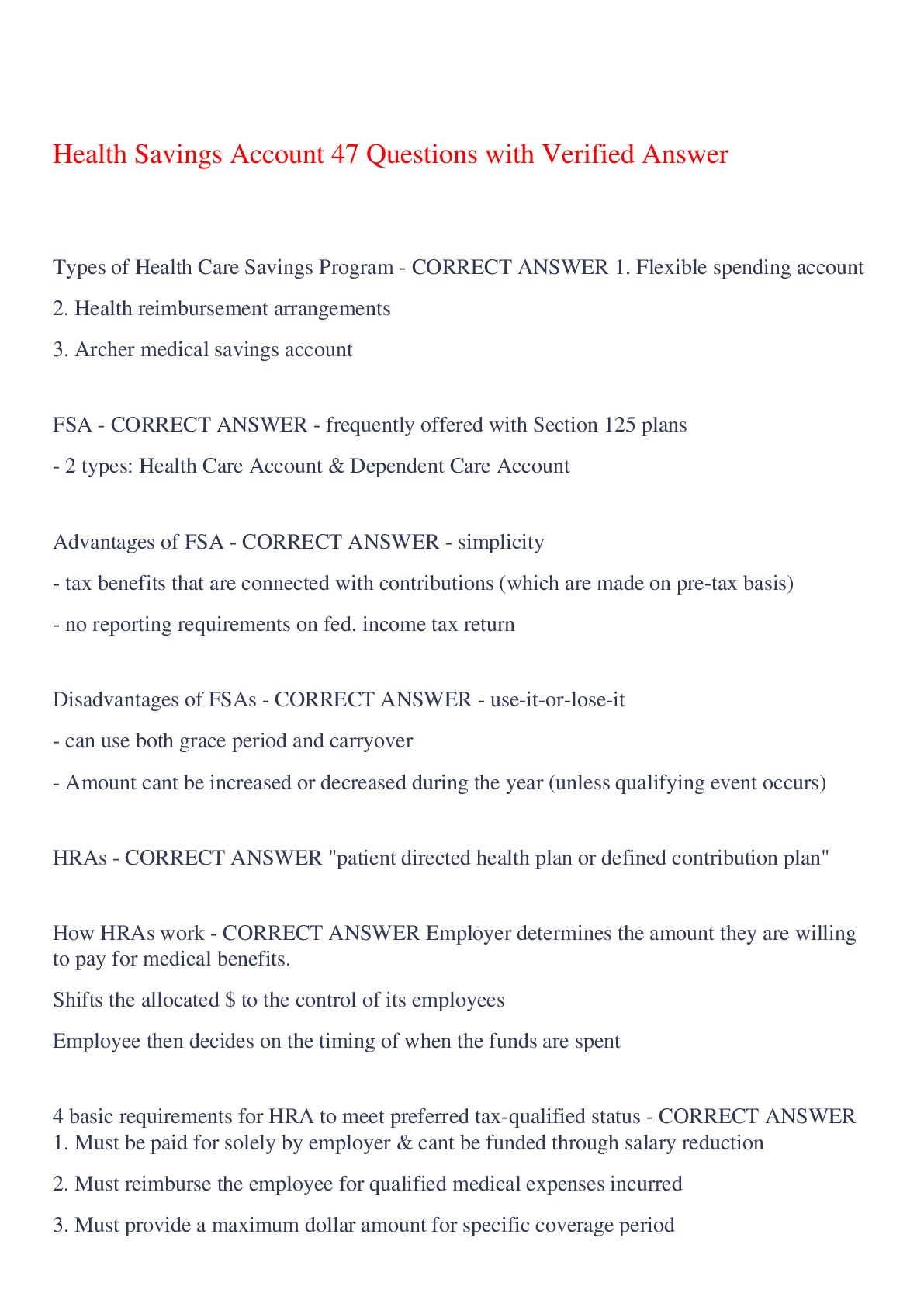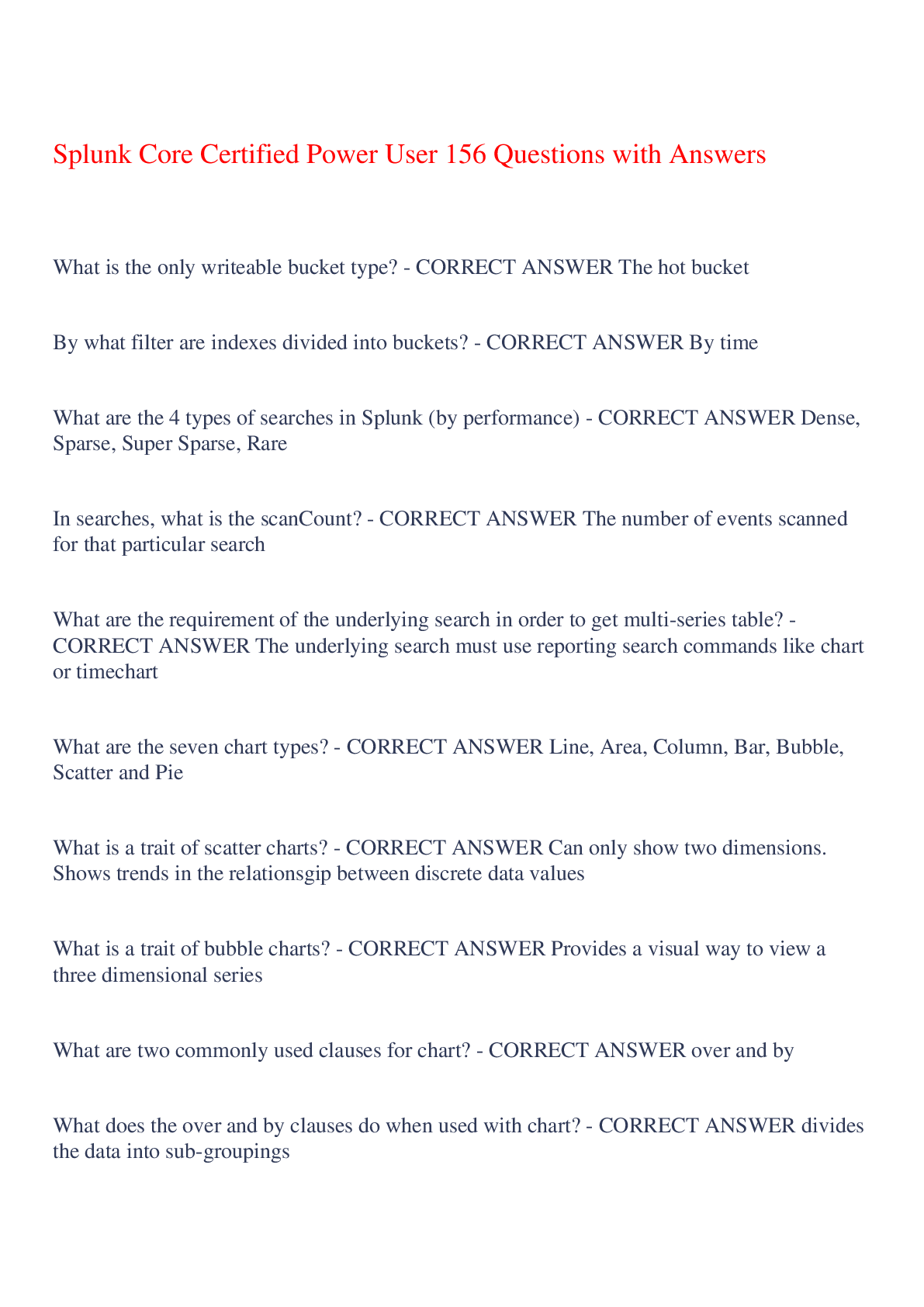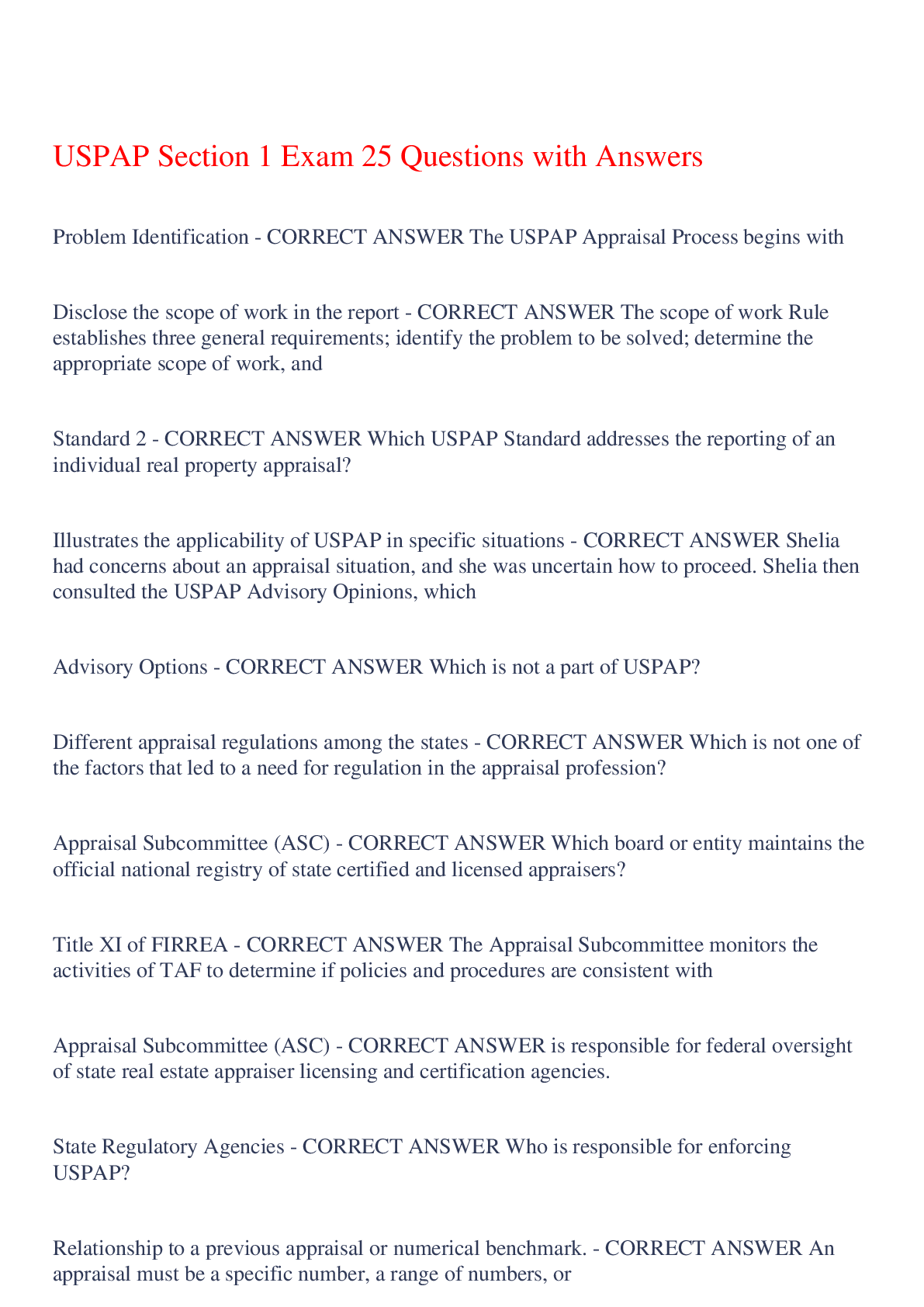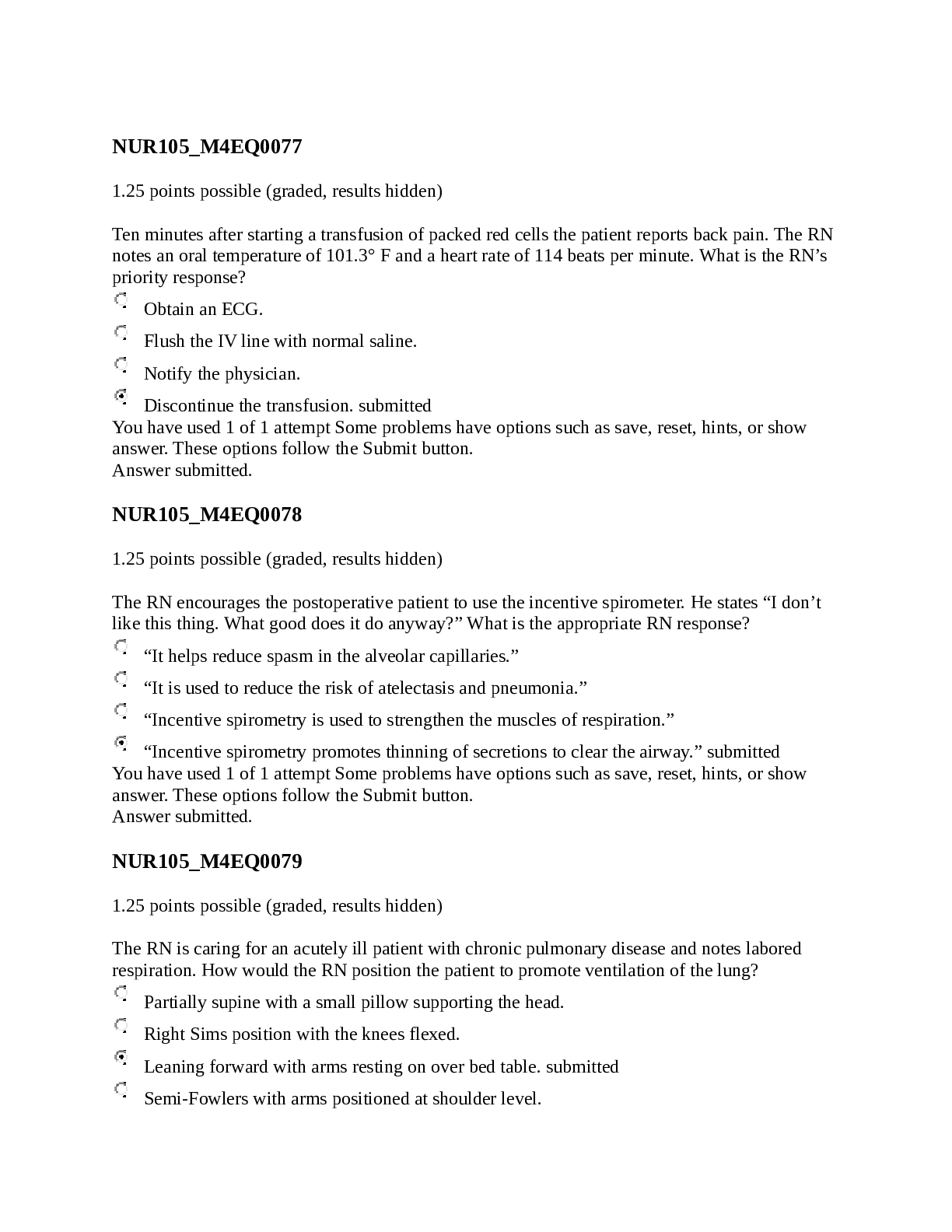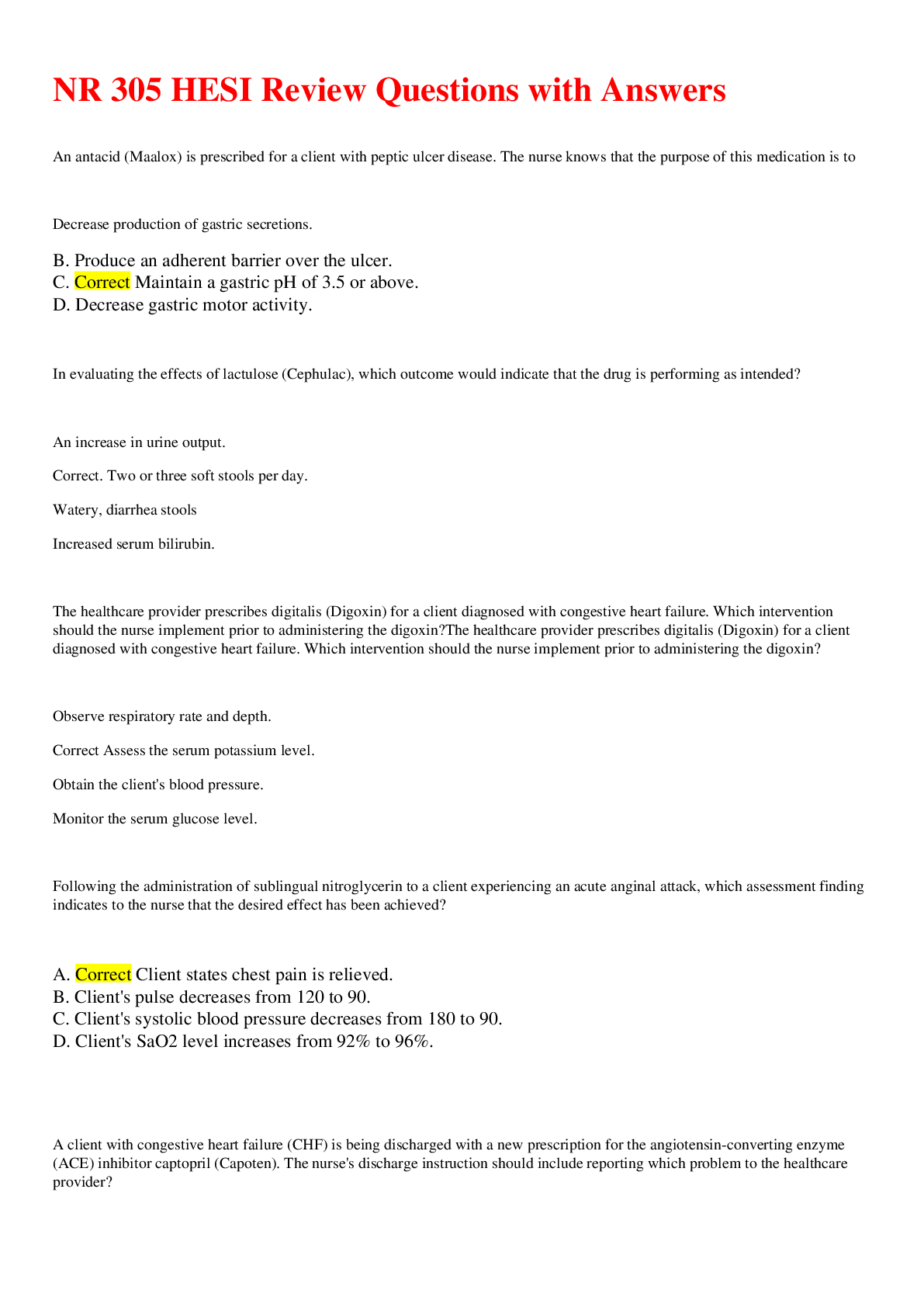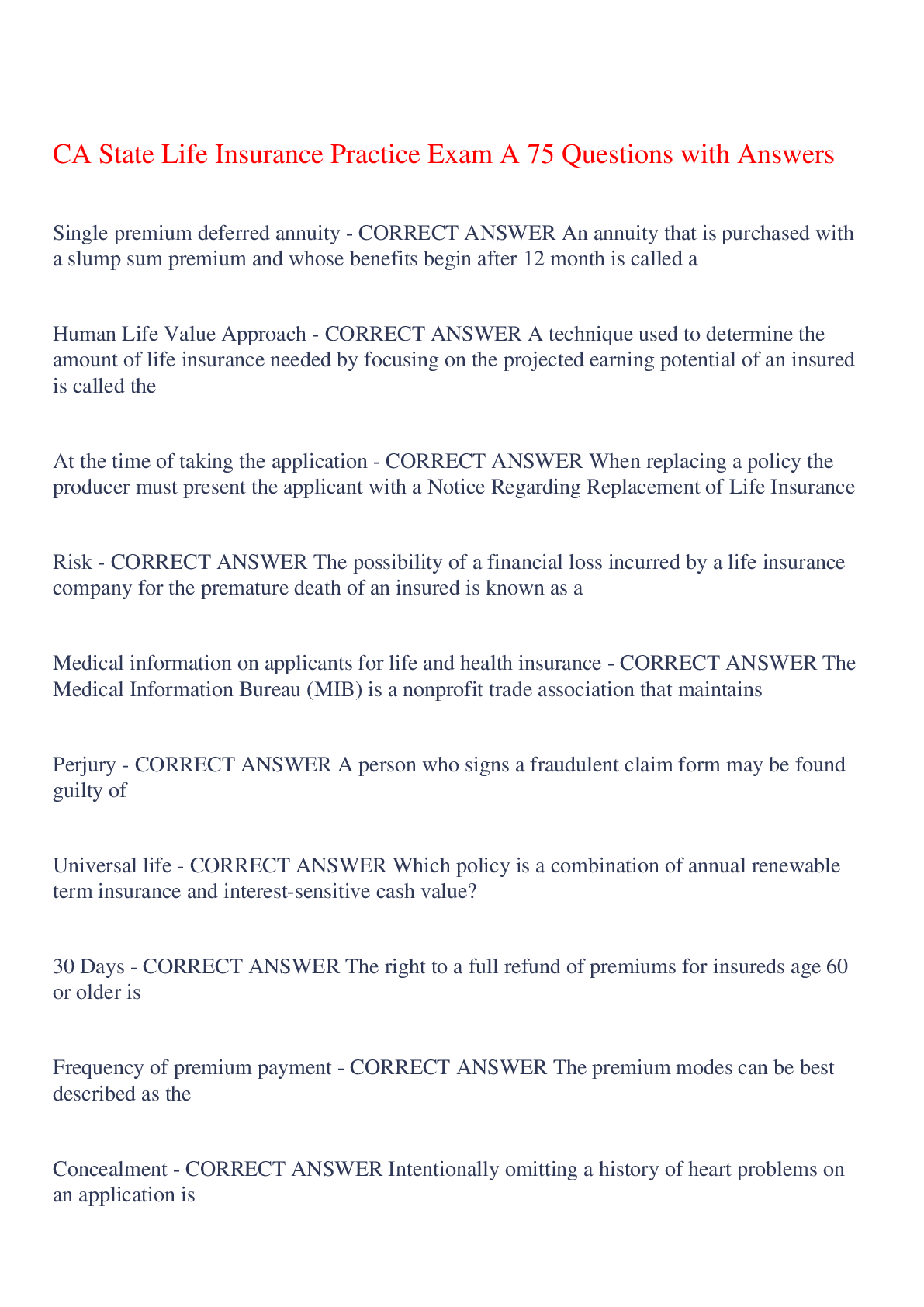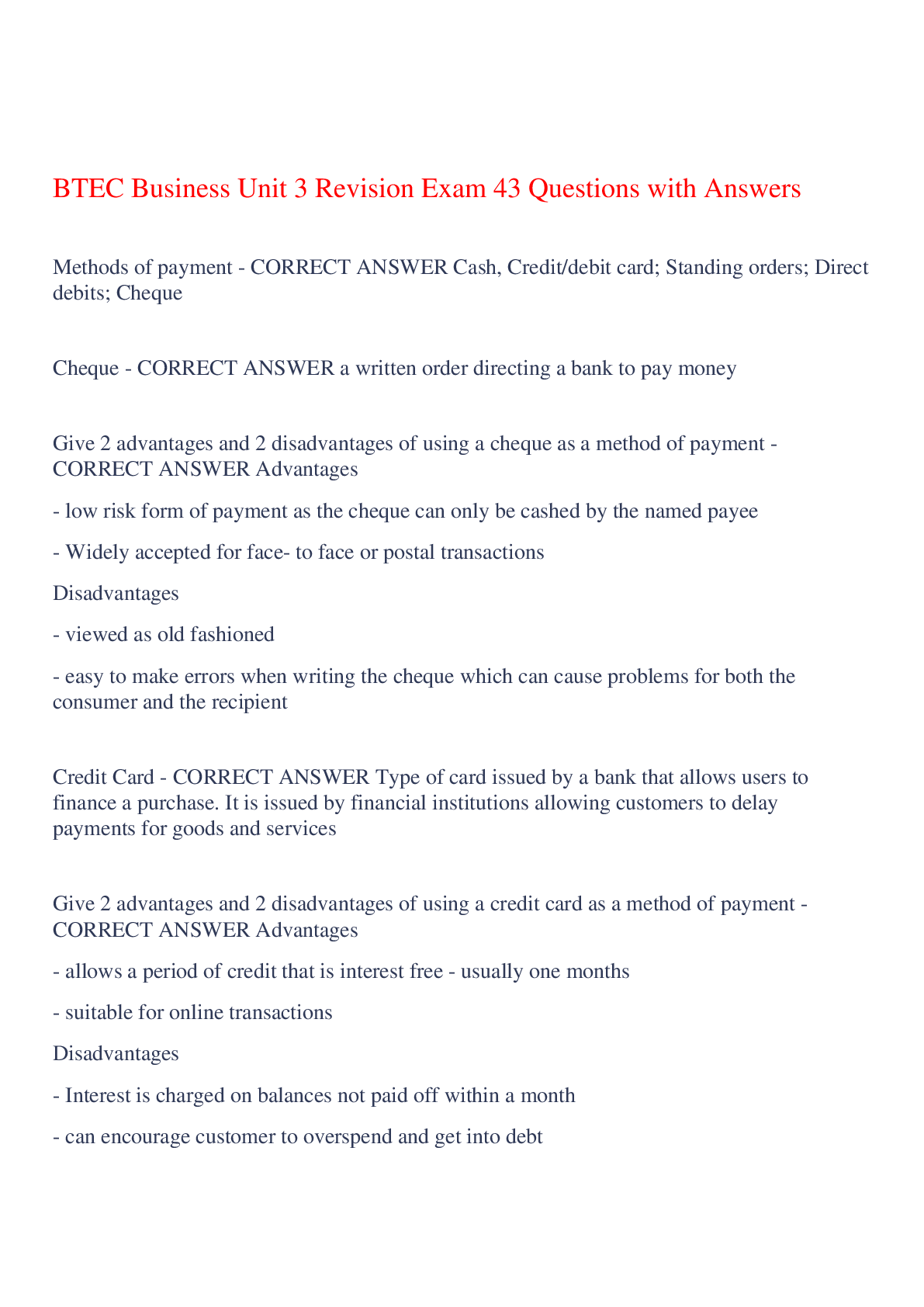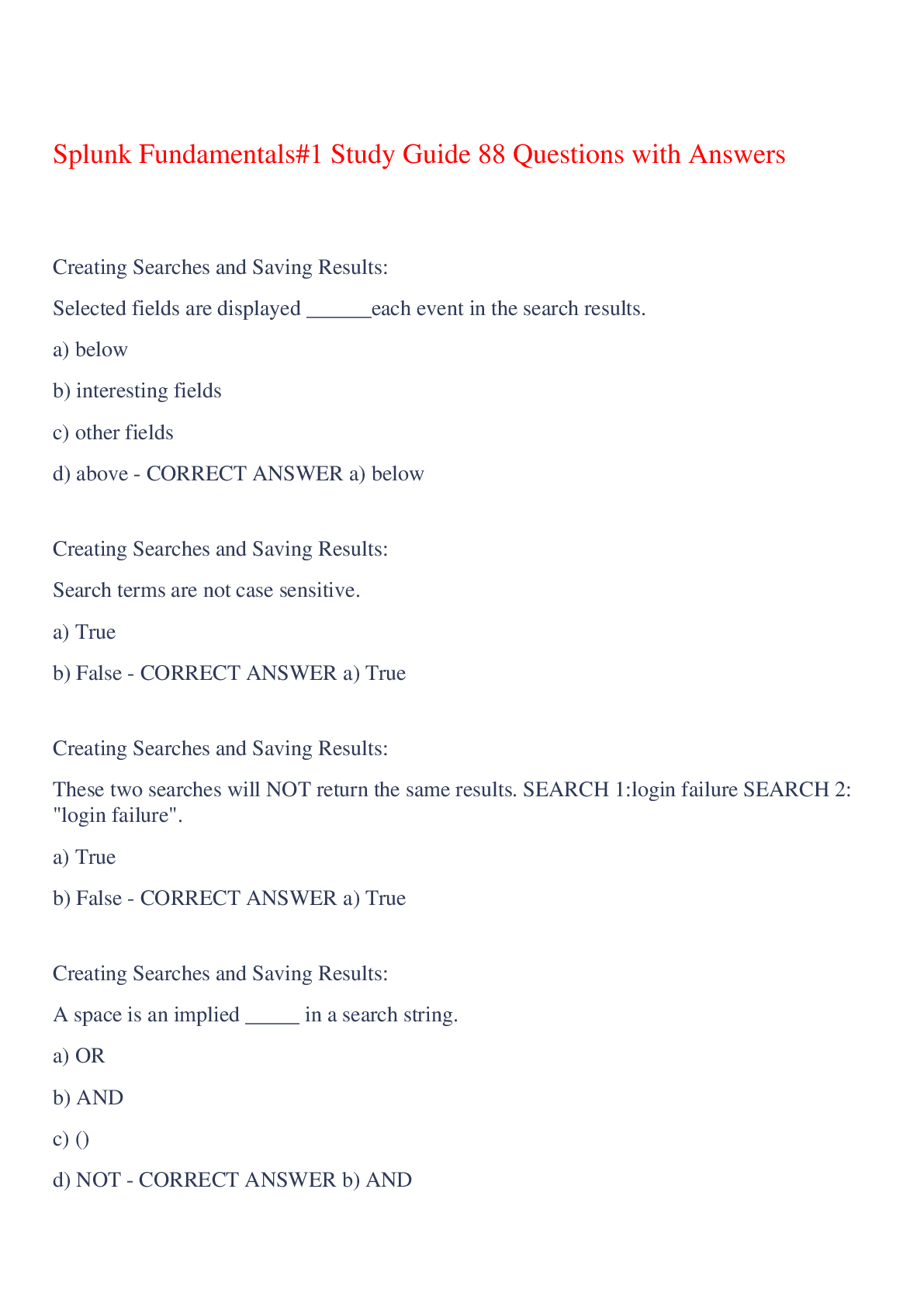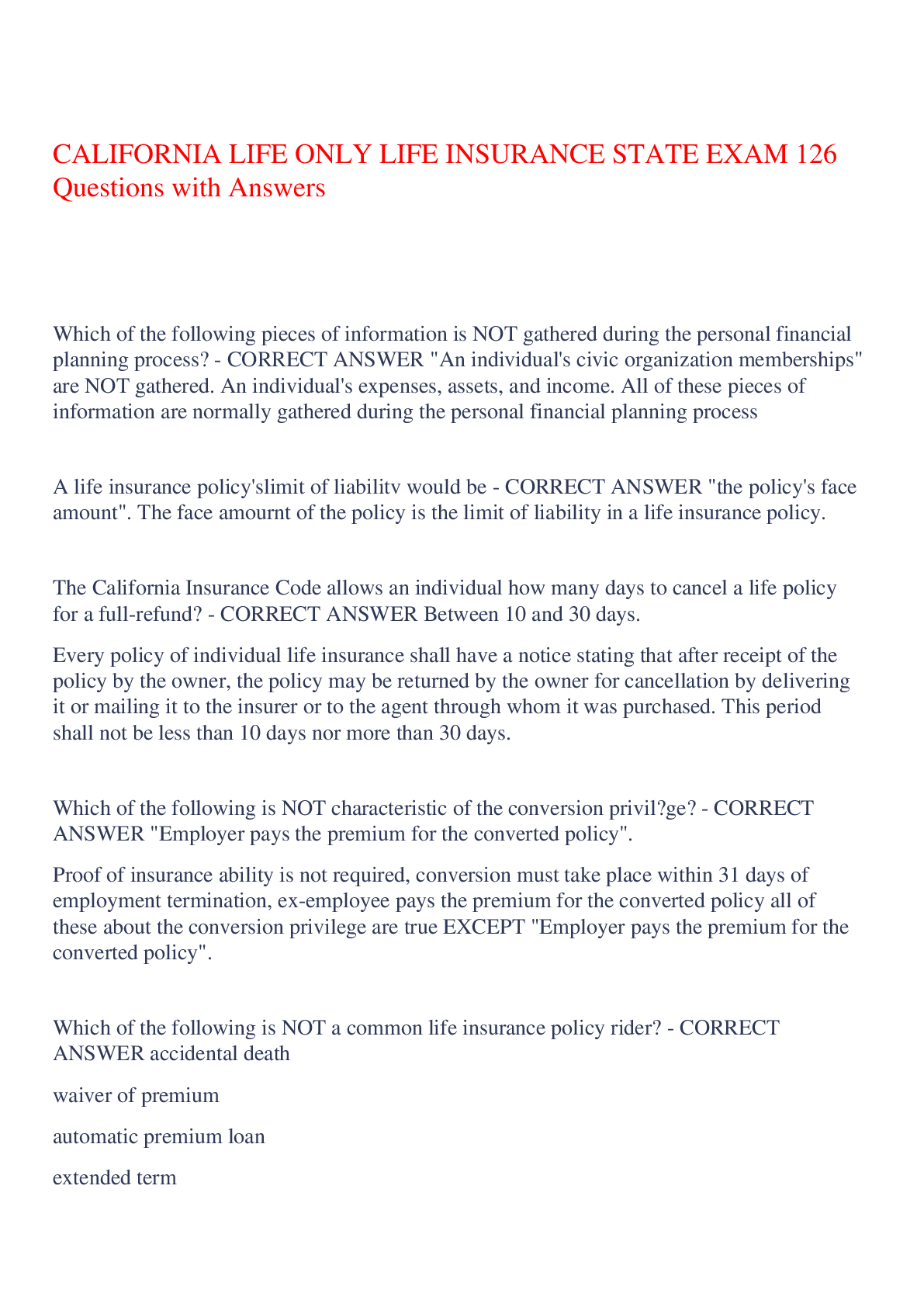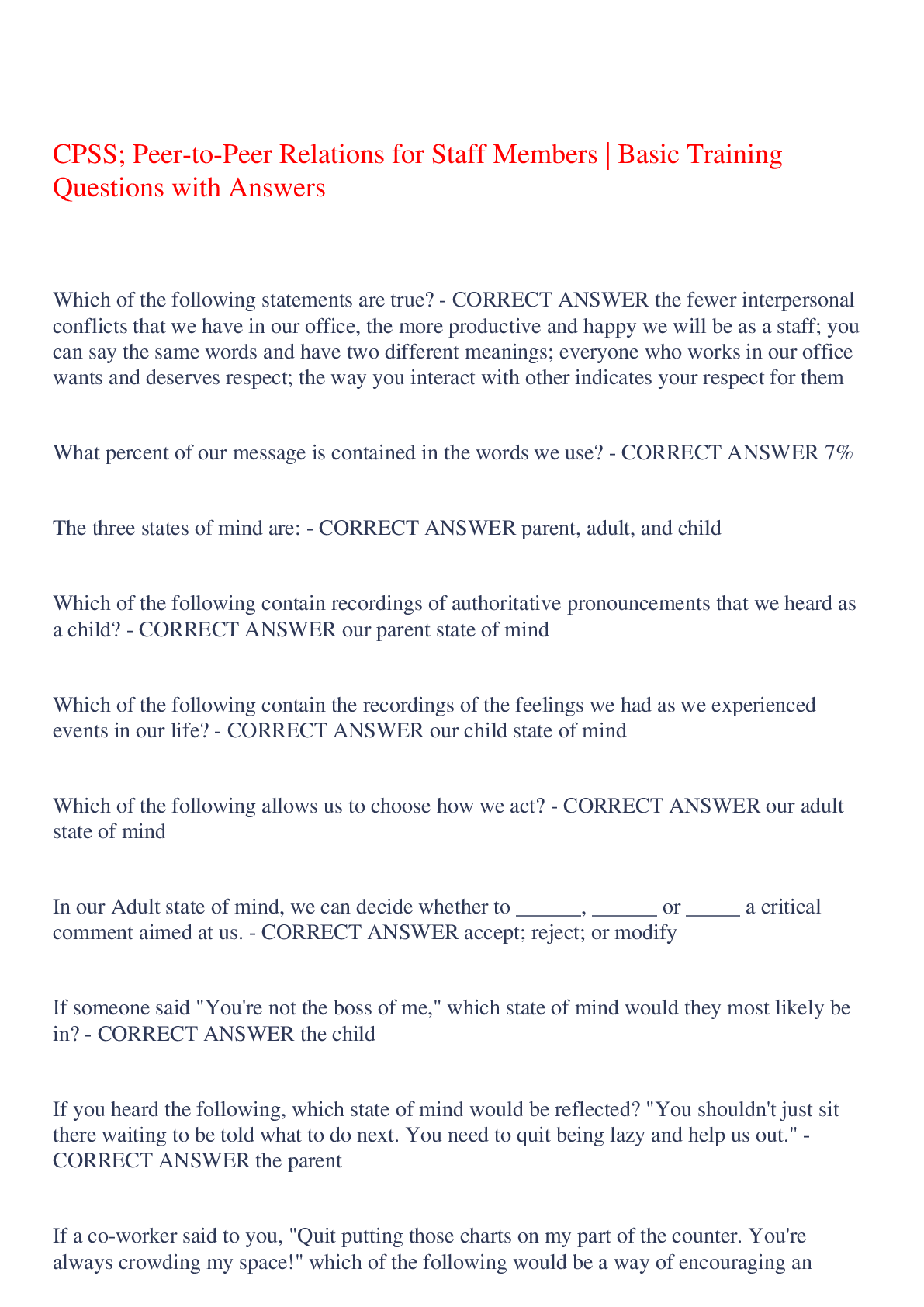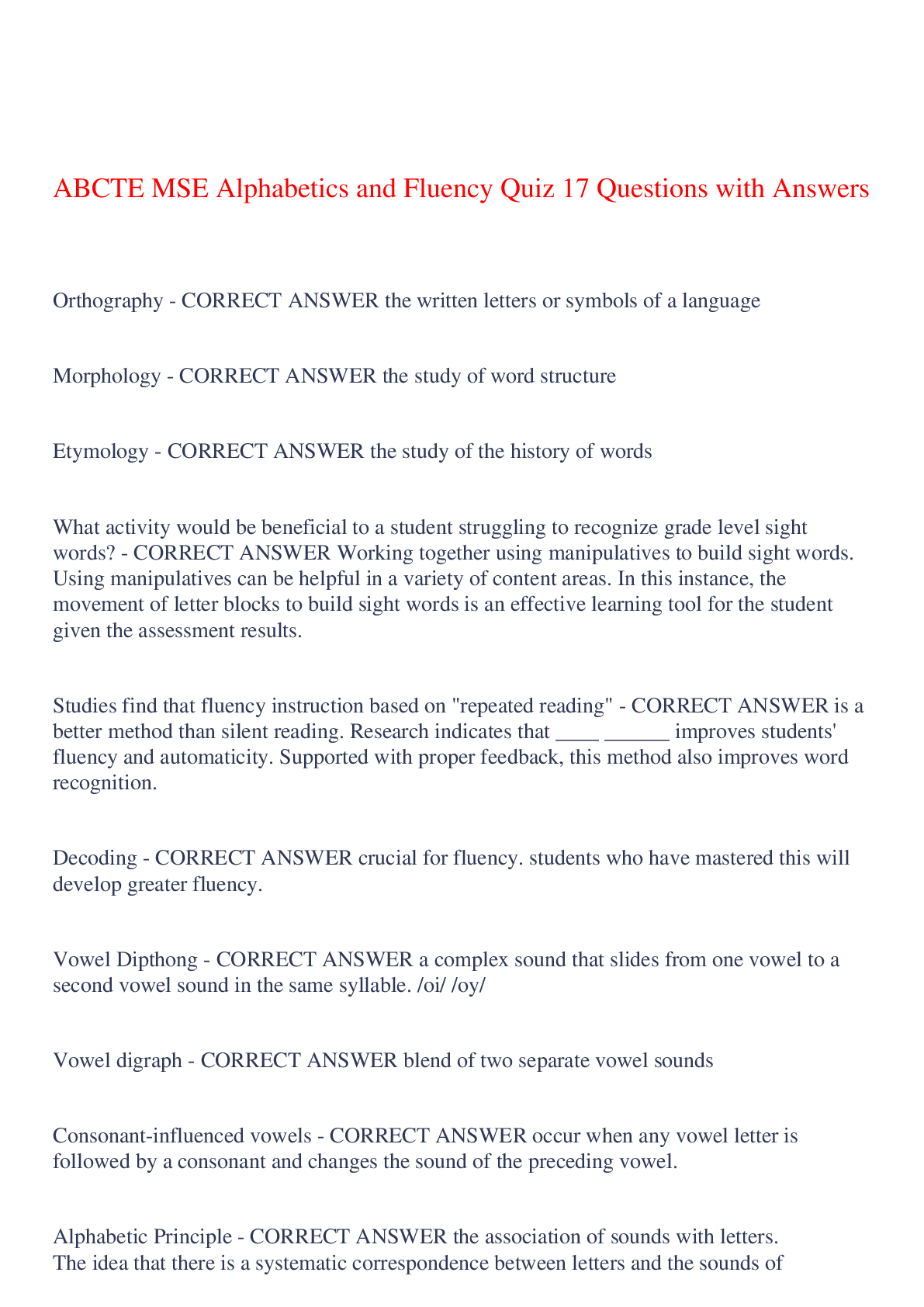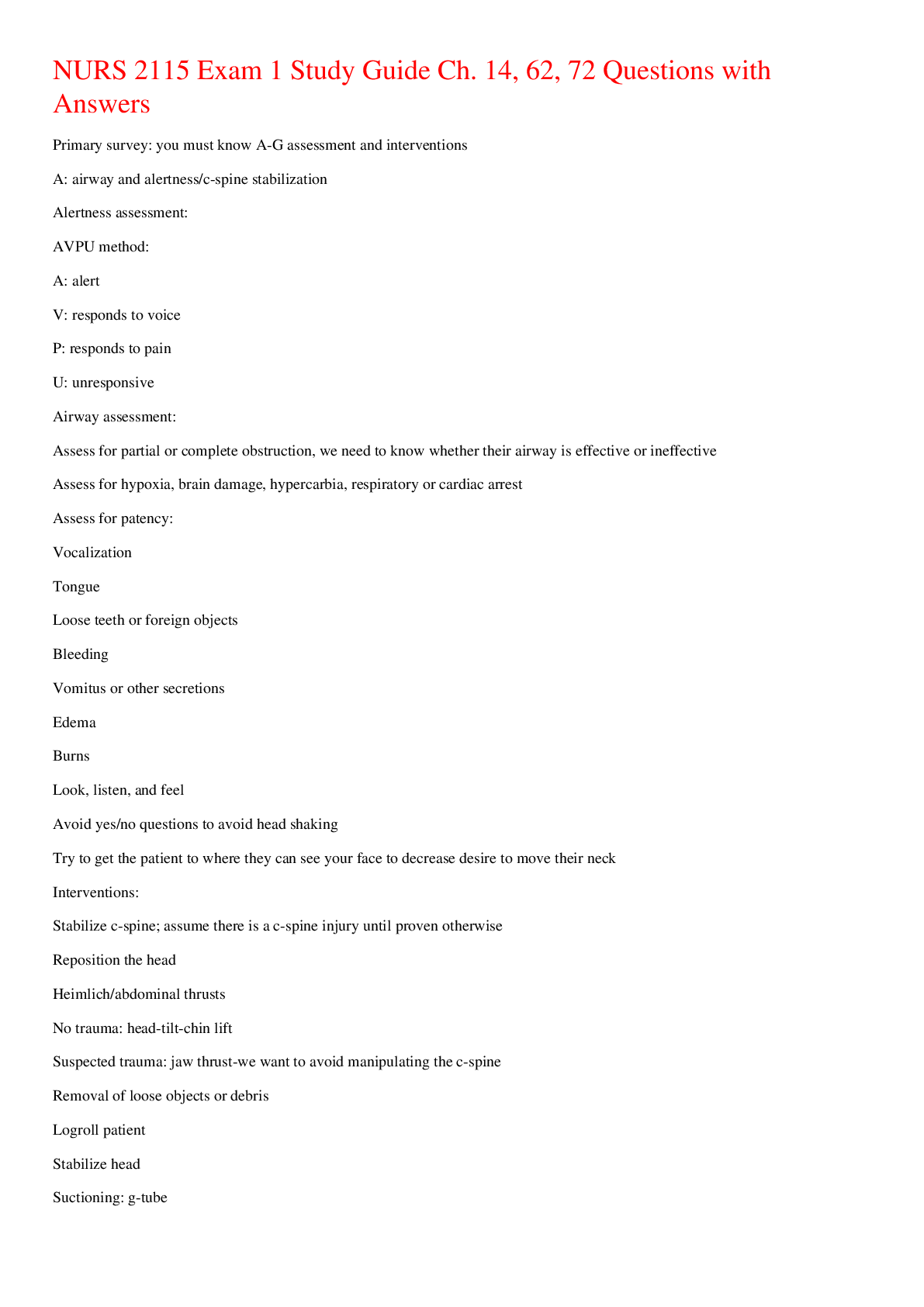Biology > EXAM > American Military University: BIOL 133 Exam 2-Chapters 7-11 Questions with Answers,100% CORRECT (All)
American Military University: BIOL 133 Exam 2-Chapters 7-11 Questions with Answers,100% CORRECT
Document Content and Description Below
American Military University: BIOL 133 Exam 2-Chapters 7-11 Questions with Answers Part 1 of 1 - 100.0 Points Question 1 of 40 Points If rubisco does not function properly, what process w... ould be affected? • A. ability to reduce NADP+ • B. ability to absorb photons • C. ability to fix carbon • D. ability to split water Feedback: Correct Question 2 of 40 2.5 Points Normal watermelons (n=11) are diploid. A. 22 B. 11 1. How many chromosomes are in a normal watermelon somatic cell? 2. How many chromosomes are in a sperm cell? Feedback: Correct Question 3 of 40 Points The net results of glycolysis are • A. 1 NADH and 1 ATP • B. 2 NADH and 2 ATP • C. 4 NADH and 2 ATP • D. 2 NADH and 4 ATP Feedback: Correct Question 4 of 40 Points If calcium levels are low, cAMP activity increases which leads to synthesis and release of parathyroid hormone. cAMP acts as a(n) • A. enzyme • B. phosphorylating agent • C. ligand • D. second messenger Feedback: Correct Question 5 of 40 Points Which event distinguishes anaphase from anaphase II? • A. Anaphase produces haploid daughter cells and anaphase II results in diploid daughter cells • B. Sister chromatids separated in anaphase II are different while they are identical in anaphase • C. Spindle fibers separate the kinetochores in chromosomes in anaphase. • D. The ploidy level will be reduced in anaphase II. • E. Homologous chromosomes are separated in anaphase and chromosomses are separated in anaphase II Feedback: Correct Question 6 of 40 Points Protein phosphorylating enzymes help regulated gene expression by • A. translation • B. DNA synthesis • C. moving mRNA into the cytoplasm • D. protein activation Feedback: Correct! Question 7 of 40 Points Yeasts life cycle is categorized as • A. Gamete-Zygote • B. Diploid-Dominant • C. Haploid-Dominant • D. Alternation of Generations Feedback: Correct! Question 8 of 40 2.5 Points In which phase are there 92 chromatids? Select all that apply. A. G1 B. S C. Prophase D. Metaphase E. Telophase Feedback: Incorrect: Learning Objective Text: Discuss the behavior of chromosomes during karyokinesis Question 9 of 40 2.5 Points Which event is similar between prophase I and prophase? Select all that apply. A. The nuclear membrane begins to disintegrate B. Spindle fibers appear C. Each chromosome is composed of two chromatids D. Chromosomes condense E. Each chromosome has potentially experienced crossover F. Tetrads are present Feedback: Correct Question 10 of 40 2.5 Points Which event may lead to cancer? Select all that apply. A. gene mutation B. functioning p53 protein C. Rb protein phosphorylating D. Improper replication of DNA during synthesis E. faulty DNA repair Feedback: Learning Objective: Describe how cancer is caused by uncontrolled cell growth Question 11 of 40 Points In a cell with 8 duplicated chromosomes, at which phase do the daughter chromosomes contain single chromatids? • A. Prophase • B. Metaphase • C. Anaphase • D. Telophase • E. Cytokinesis Feedback: Learning Objective: Discuss the behavior of chromosomes during karyokinesis Question 12 of 40 Points Which statement describes the relationship of cancer control genes? • A. Proto-oncogenes and tumor suppressor genes increase cell division • B. Proto-oncogenes and tumor suppressor genes decrease cell division • C. Proto-oncogenes increase cell division and tumor suppressor genes decrease cell division • D. Proto-oncogenes decrease cell division and tumor suppressor genes increase cell division Feedback: Learning Objective: Describe how tumor suppressors function Question 13 of 40 2.5 Points Chromosome duplication occurs for the beginning of which process? Select all that apply. A. mitosis B. meiosis I C. meiosis II D. interkinesis E. cytokinesis Feedback: Incorrect- Learning Objective Text: Explain the differences in meiosis and mitosis. Question 14 of 40 Points In vertebrate immune systems, some t-lymphocytes will make a growth factor that drives their own division. This represents • A. autocrine signaling • B. paracrine signaling • C. direct signaling • D. endocrine signaling Feedback: Incorrect: Learning Objective Text: Describe four types of signaling found in multicellular organisms Question 15 of 40 2.5 Points Damaged DNA can potentially be repaired during which checkpoint. Select all that apply. A. G1 B. S C. G2 D. G0 Feedback: Correct Question 16 of 40 2.5 Points What properties are expressed by wavelengths? Select all that apply. A. Visible light’s wavelengths are between 400-740nm B. Red absorbs little energy C. Green is useful in absorbing light during photosynthesis D. Chlorophyll b absorbs a lot of energy from 460nm wavelengths E. Chlorophyll a reflects red light well Feedback: Correct Question 17 of 40 Points Depolarization of one group of smooth muscle cells rapidly spreads to other smooth muscle cells, leading to coordinated contractions. This electrical coupling is due to • A. autocrine signaling • B. paracrine signaling • C. endocrine signaling • D. direct signaling Feedback: Learning Objective: Describe four types of signaling found in multicellular organisms Question 18 of 40 Points A human fertilized egg contains one chromosome with HbS, the allele for sickle cell disease, and a homologous chromosome with Hbs, the wildtype allele. It also contains an X and Y chromosome. At what point will meiosis occur to create cells that are either HbS or Hbs ? • A. Within the hour, as fertilization proceeds. • B. Within the week, as embryonic development proceeds. • C. Years later, when gametogenesis proceeds. • D. Decades later, in the grandchildren of this individual. Feedback: Correct Question 19 of 40 Points Which event most accurately describes cytokinesis? • A. Cell walls prevent cleavage furrow from deepening. • B. Actin molecules are used to develop the cell plate. • C. The metaphase plate is the beginning area for cytokinesis • D. Phragmoplast develop in animal cells at the metaphase plate. • E. Cytokinesis can begin as early as metaphase. Feedback: Learning Objective: Explain how the cytoplasmic content is divided during cytokinesis Question 20 of 40 2.5 Points In gluconeogenesis, organisms use ATP to make glucose, then in cellular respiration they break down the glucose again to get energy. Why not just store the ATP? (Select all that apply.) A. ATP does not have high-energy bonds. B. ATP is not energy dense enough. C. ATP only has energy after it is activated by glucose. D. ATP only has energy when it is attached to glucose. E. ATP is not stable enough. F. ATP without a cofactor forms crystalline structures. G. Using glucose directly to power enzymes is more efficient. Feedback: Learning Objective: Analyze the reactions of cellular respiration in terms of net energy input and output using critical thinking skills. Question 21 of 40 Points Which describes the relationship between gametes and spores? • A. gametes can fuse to become a zygote, but spores can develop into organisms without forming a zygote • B. gametes, not spores, can only contribute to genetic diversity in populations • C. gametes are always haploid and spores are always diploid • D. gametes come directly from sporophytes to develop into gametophytes Feedback: Learning Objective: Describe the three different life-cycle types among sexual multicellular organisms and their commonalities Question 22 of 40 Points A human sperm will contain chromosomes. • A. 23 • B. 46 • C. 23 pairs of • D. 46 pairs of Feedback: Correct Question 23 of 40 Points What is the minimum number of chiasmata in a tetrad? • A. 1 • B. 2 • C. 3 • D. 4 Feedback: Incorrect: Learning Objective Text: Describe the behavior of chromosomes during meiosis Question 24 of 40 Points The electron transport chain between photosystem II and photosystem I generate a proton gradient which drives ATP synthase known as • A. diffusion • B. chemiosmosis • C. active transport • D. osmosis Feedback: Incorrect: Learning Objective Text: Describe how and where photosynthesis takes place within a plant Question 25 of 40 Points NADH and FADH2 are products of • A. glycolysis • B. chemiosmosis • C. oxidation/reduction reactions • D. substrate level phosphorylation Feedback: Correct Question 26 of 40 Points membranes can be found in a chloroplasts. • A. 1 • B. 2 • C. 3 • D. 4 Feedback: Correct Question 27 of 40 Points What vitamin derivative accepts hydrogen for complex I during ETC? • A. thiamine • B. riboflavin • C. niacin • D. pantothenic acid Feedback: Correct Question 28 of 40 Points What statement describes protein phosphorylation? • A. cyclic AMP is an inhibitor of protein kinase A • B. serine is often phosphorylated • C. dephosphorylation occurs when ATP is regenerated • D. phosphatase catalyzes a transfer of a phosphate Feedback: Learning Objective: Recognize the role of phosphorylation in the transmission of intracellular signals Question 29 of 40 Points What vitamin acts as a coenzyme in cell respiration and is important in alcohol fermentation? • A. thiamine • B. riboflavin • C. niacin • D. pantothenic acid Feedback: Learning Objective: Describe the type of fermentation that readily occurs in animal cells and the conditions that initiate that fermentation Question 30 of 40 Points To efficiently provide the ideal amount of nitrogen fertilizer, some farmers make use of a “chlorophyll meter” that measures the amount of green light reflected off a leaf. Why does this provide an indication of whether the plant may need more or less nitrogen? • A. Nitrogen ions form the electrochemical gradient across the thylakoid membrane that drives ATP synthesis. • B. Beta-carotene is composed largely of nitrogen atoms, and has a similar absorption to chlorophyll. • C. Each chlorophyll molecule contains four nitrogen atoms that surround the Mg2+ ion, and these account for most of the nitrogen in a leaf. • D. Nitrogen gas is green, and photosynthesis uses N2 to run the Calvin cycle. Feedback: Correct Question 31 of 40 Points What is the relationship between cellular aerobic respiration and photosynthesis? • A. The processes occur in the same organelles • B. They use the same reactants and produce the same products • C. They are inverse of each other • D. They are reverse of each other Feedback: Learning Objective: Explain how photosynthesis works in the energy cycle of all living organisms Question 32 of 40 Points When has glucose been broken down from its original 6 carbon molecule to 2 carbon dioxides in the citric acid cycle? • A. oxidation of pyruvate • B. CoA is bound to sulfhydryl group • C. when isocitrate is oxidized to α-Ketoglutarate • D. when α-Ketoglutarate is oxidized to Succinyl CoA • E. condensation of acetyle-CoA with oxaloacetate Feedback: Learning Objective: Explain how a circular pathway, such as the citric acid cycle, fundamentally differs from a linear pathway, such as glycolysis Question 33 of 40 Points Phosphofructokinase, a controlling enzyme of glycolysis, is inhibited by and activated by . • A. ATP;ADP • B. ADP;ATP • C. ADP;NADH • D. NADH;ATP • E. NADH;ADP Feedback: Correct Question 34 of 40 Points When the p53 gene is damaged, which event may happen? • A. Cells can divide uncontrollobly • B. Cells will fix the DNA pass the G1 checkpoint • C. Cells will pass the G2 checkpoint • D. Cells will always undergo apoptosis Feedback: Incorrect- Learning Objective Text: Describe the molecules that control the cell cycle through positive and negative regulation Question 35 of 40 Points P700 first transfers an electron through chlorophyll and a bound • A. quinone • B. ferredoxin • C. 2Fe-2S • D. plastocyanin Feedback: Correct Question 36 of 40 Points carbon dioxide molecules are given off during three turns of the Krebs cycle? • A. 1 • B. 2 • C. 3 • D. 4 • E. 6 Feedback: Incorrect: Learning Objective Text: Explain how a circular pathway, such as the citric acid cycle, fundamentally differs from a linear pathway, such as glycolysis Question 37 of 40 2.5 Points Inositol phopholipids are (select all that apply) A. present in large concentrations in the plasma membrane B. located near membrane-bound receptors C. can be converted to second messengers D. can interact directly with DNA in the nucleus Feedback: Incorrect- Learning Objective Text: Explain how the binding of a ligand initiates signal transduction throughout a cell Question 38 of 40 Points are ligands, which promote cell growth. • A. Apoptosis • B. Inhibitors • C. Growth factors • D. Autoinducers Feedback: Correct! Question 39 of 40 Points If a sperm contains 12 chromosomes, it came from an organism that had • A. 6 chromosomes • B. 12 chromosomes • C. 24 chromosomes • D. 36 chromosomes Feedback: Learning Objective: Describe the structure of prokaryotic and eukaryotic genomes Question 40 of 40 2.5 Points What is not a good biological oxidizing agent? • A. Fe3+ • B. O2 • C. NAD+ • D. FAD Feedback: Correct [Show More]
Last updated: 11 months ago
Preview 1 out of 23 pages
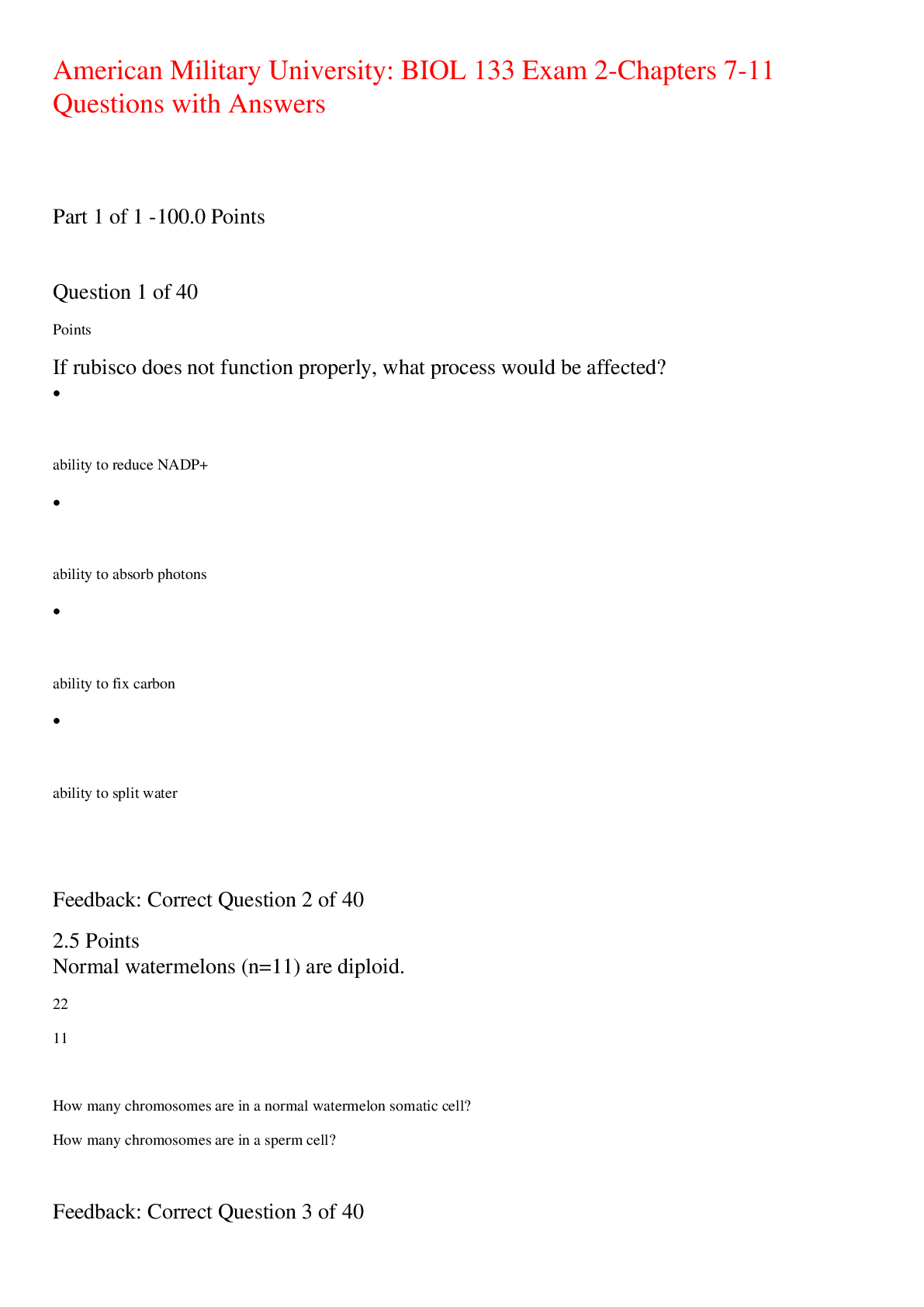
Reviews( 0 )
Document information
Connected school, study & course
About the document
Uploaded On
May 19, 2023
Number of pages
23
Written in
Additional information
This document has been written for:
Uploaded
May 19, 2023
Downloads
0
Views
64













